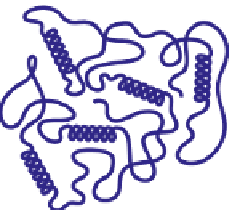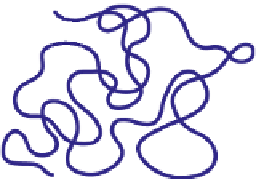Biomedical Engineering Reference
In-Depth Information
(a)
Solution
(b)
Formation
of helices
(c)
Formation
of network
Two-step mechanism of gelation for s-PMMA: (a) hot solution; (b) formation of single helices;
(c) initial formation of the network by aggregation of helices. Adapted with permission from
Berghmans et al.(
1994
) © 1994 American Chemical Society.
Figure 8.15
process, as assumed by other authors. Instead, the occurrence of a two-step gelation
mechanism suggested the initial formation of a single helix. According to these
authors, the formation of double helices in the
first step would lead to a much faster
intermolecular network formation, as the physical cross-links could already be
formed in this step.
ThemainconclusionbyBerghman
s group, drawn from these studies on stereo-
regular PMMA solutions, is that thermoreversible gelation occurs in two steps, by a
mechanism quite different from the crystallization gelation systems. Generally this
last type of gelation is nucleation-controlled, occurring at a certain degree of under-
cooling (crystalline cross-links, with a fringed micellar structure) (Berghmans et al.,
1979
). Here a random coil diffuses from the surroundings (melt or solution) on to the
growing crystal surface and is laid down in a regular manner. Consequently, the
polymer chains acquire their regular conformation only when entering the crystal
lattice. The change in molecular conformation takes place during the formation of the
crystal, and the helix gets its stability from its incorporation into the crystal lattice. In
their review article, Spevacek and Schneider (
1987
) supported a different point of
'








































































Search WWH ::

Custom Search